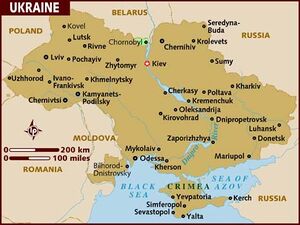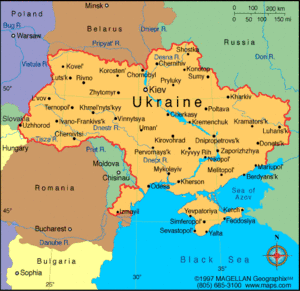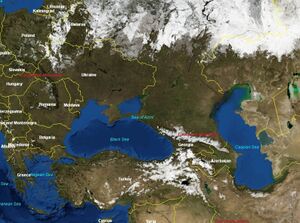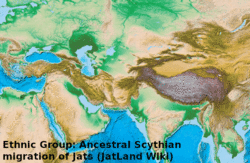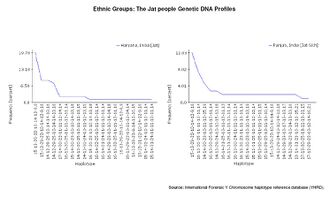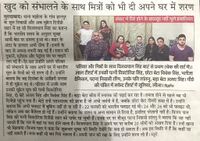Ukraine
| Author:Laxman Burdak, IFS (R) |
Ukraine (English pronunciation: Ukrayina), is a country in Eastern Europe.
Contents
Location
It borders Russia to the east, Belarus to the north, Poland, Slovakia and Hungary to the west, Romania and Republic of Moldova to the southwest, and the Black Sea and Sea of Azov to the south. The city of Kiev (Kyiv) is Ukraine's capital.
History
From at least the ninth century, the territory of present-day Ukraine was a centre of medieval East Slavic civilization, that formed the state that became known as Kievan Rus; and for the following several centuries the territory was divided between a number of regional powers.
Human settlement in the territory of Ukraine has been documented into distant prehistory. The late neolithic Trypillian culture flourished from ca. 4500 BC to 3000 BC.
In antiquity, the southern and eastern parts of modern Ukraine were populated by Iranian nomads called Scythians. The Scythian Kingdom existed on this land between 700 BC and 200 BC. In the third century, the Goths arrived, calling their country Oium, and formed the Chernyakhov culture before moving on and defeating the Roman empire. In the 7th century, the territory of the modern Ukraine was the core of the state of the Bulgars (often referred to as Great Bulgaria), who had their capital in the city of Phanagoria.
The majority of the Bulgar tribes migrated in several directions at the end of the seventh century, and the remains of their state was swept by the Khazars, a Turkic semi-nomadic people from Central Asia, which later adopted Judaism. The Khazars founded the independent Khazar kingdom in the southeastern part of today's Europe, near the Caspian Sea and the Caucasus. In addition to western Kazakhstan, the Khazar kingdom also included territory in what is now eastern Ukraine, Azerbaijan, southern Russia, and Crimea.
Ukraine antiquity
Part of Scythia in antiquity and settled by Getae, in the migration period, Ukraine is also the site of early Slavic expansion, and enters history proper with the establishment of the medieval state of Kievan Rus', which emerged as a powerful nation in the Middle Ages but disintegrated in the 12th century.
Settlement in Ukraine by members of the genus Homo has been documented into distant prehistory. The Neanderthals are associated with the Molodova archaeological sites (45,000–43,000 BC) which include a mammoth bone dwelling.[1][2] Gravettian settlements dating to 32,000 BC have been unearthed and studied in the Buran-Kaya cave site of the Crimean Mountains.[3][4]
Around 90,000 years ago the West Siberian rivers were blocked by an ice sheet and emptied via the Aral Lake, Caspian Sea, and the Manych basin into the Black Sea, thus forming a kind of worldwide longest "river".[5]
In the late Neolithic times the Cucuteni-Trypillian Culture flourished from about 4,500–3,000 BC.[6] The Copper Age people of the Cucuteni-Trypillian Culture resided in the western part, and the Sredny Stog Culture further east, succeeded by the early Bronze Age Yamna ("Kurgan") culture of the steppes, and by the Catacomb culture in the 3rd millennium BC.
During the Iron Age, these peoples were followed by the Dacians as well as nomadic peoples like the Cimmerians (archaeological Novocherkassk culture), Scythians and Sarmatians. The Scythian kingdom existed here from 750 to 250 BC.[7] Along with other ancient Greek colonies founded in the 6th century BC on the northeastern shore of the Black Sea, the colonies of Tyras, Olbia, Hermonassa continued as Roman and Byzantine cities until the 6th century AD.
In the 3rd century AD, the Goths arrived in the lands of modern Ukraine around 250–375 AD, which they called Oium, corresponding to the archaeological Chernyakhov culture.[8]The Ostrogoths stayed in the area but came under the sway of the Huns from the 370s. North of the Ostrogothic kingdom was the Kyiv culture, flourishing from the 2nd–5th centuries, when it was also overrun by the Huns. After they helped defeat the Huns at the battle of Nedao in 454, the Ostrogoths were allowed by the Romans to settle in Pannonia.
With the power vacuum created with the end of Hunnic and Gothic rule, Slavic tribes, possibly emerging from the remnants of the Kyiv culture, began to expand over much of the territory that is now Ukraine during the 5th century, and beyond to the Balkans from the 6th century.
In the 7th century, the territory of modern Ukraine was the core of the state of the Bulgars (often referred to as Old Great Bulgaria) with its capital city of Phanagoria. At the end of the 7th century, most Bulgar tribes migrated in several directions and the remains of their state were absorbed by the Khazars, a semi-nomadic people from Central Asia.[9]
The Khazars founded the Khazar kingdom near the Caspian Sea and the Caucasus. The kingdom included western Kazakhstan and parts of Crimea, eastern Ukraine, southern Russia and Azerbaijan.
Antes people: In the 5th and 6th centuries, the Antes Union was located in the territory of what is now Ukraine. The Antes were the ancestors of Ukrainians: White Croats, Severians, Polans, Drevlyans, Dulebes, Ulichians, and Tiverians. Migrations from Ukraine throughout the Balkans established many South Slavic nations. Northern migrations, reaching almost to the Lake Ilmen, led to the emergence of the Ilmen Slavs, Krivichs, and Radimichs, the groups ancestral to the Russians. After an Avar raid in 602 and the collapse of the Antes Union, most of these peoples survived as separate tribes until the beginning of the second millennium.[10]
Jats in Ukraine
I. Sara, a Canadian barrister and solicitor has pointed out that the recent excavations in the Ukraine and Crimea provide visible links of Jats and Scythians.
Cap. Dalip Singh Ahalawat has reported in an article published in Jat Samaj Patrika (Oct./Nov. 1991), that Jats had ruled in Scythia and Central Asia. He has given a list of about 70 Jat gotras who have ruled over there.
Cap. Dalip Singh has mentioned following Jat gotras who ruled over Scythia and Central Asia, in his book "Jat veeron ka itihaas"[11]- 1.Saka 2.Barbar 3.Shivi 4.Palhav 5.Chol 6.Kamboj 7.Valhik 8.Pandyav 9.Rishik 10.Tushar 11.Kundu 12.Nagavanshi 13.Kalkhande 14.Kang 15.Darad 16.Sihag 17.Her 18.Bhullar 19.Dahiya 20.Maurya-Maur 21.Nav-Nauvar 22.Yaudheya 23.Jakhar 24.Punia 25.Gaur 26.Naga 27.Kalkal 28.Kuru-Kaurav 29.Tomar-Tanwar 30.Tur 31.Tatran 32.Maan 33.Ven 34.Ojhlan 35.Kashyap 36.Kaswan 37.Kuran 38.Pahalvi 39.Sandharan 40.Odhran 41.Hans 42.Dabas 43.Chahal 44.Sikarwar 45.China 46.Gill 47.Gujar 48.Johal 49.Lamba 50.Chhikara 51.Ghangas 52.Nohwar 53.Puruya-Paurav 54.Ahlawat 55.Kataria 56.Khatkar 57.Rathi 58.Sindhu 59.Chalukya 60.Gulia 61.Kuntal-Khoontal 62.Khasa 63.Tangal 64.Utar 65.Sheoran 66.Mirdha-Mira 67.Baraich 68.Shishi 69.Dagar 70.Bhadra.
According to a survey report by http://www.joshuaproject.net , there are about 32000 Jats in Ukraine, and their language is Jatali.
The search of Russian surnames as studied by Blitz in year 2002 on its Ethnic, Religious, and National Index, revealed a number of common surnames between Jats of India and the native population. For example, there is surname - Burdakov (Burdakoff). Similarly, many Jat surnames can be found on it. The URL address of this site is - http://feefhs.org/blitz/frgblitz.html . On the above site there are surnames related with JAT. These are – Lartsev (Yartsev, Jartsev), Lartsov (Jartsov, Yartsov, Jartsoff, Yartsoff), Latskov (Yatskov, Jatskov, Yatzkov, Jatzkov).
Here variants of surnames are given in brackets. It is also to be noted that “L”,“Y” and “J” are inter changeable. One can find more surnames on this Russian site, which are similar to those, found in Jats of India.
B. S. Nijjar suggests:
- "The Jats are the descendants of Scythians, whose kingdom's capital was Scythia, in the present Ukraine (Ukrainian), Soviet Social Republic, is the constituent Republic of the European USSR (Population 49,757,000) in 1947. Now Ukraine's capital is Kiev, the third leading city in Russia. Before the invasion of the golden herd, 13th century B.C. Scythian, ancient kingdom of indeterminate boundaries, centered in the area north of the Black Sea."[12]
DNA study on Y-STR Haplogroup Diversity in the Jat Population
David G. Mahal and Ianis G. Matsoukas[13] conducted a scientific study on Y-STR Haplogroup Diversity in the Jat Population of which brief Conclusion is as under:
The Jats represent a large ethnic community that has inhabited the northwest region of India and Pakistan for several thousand years. It is estimated the community has a population of over 123 million people. Many historians and academics have asserted that the Jats are descendants of Aryans, Scythians, or other ancient people that arrived and lived in northern India at one time. Essentially, the specific origin of these people has remained a matter of contention for a long time. This study demonstrated that the origins of Jats can be clarified by identifying their Y-chromosome haplogroups and tracing their genetic markers on the Y-DNA haplogroup tree. A sample of 302 Y-chromosome haplotypes of Jats in India and Pakistan was analyzed. The results showed that the sample population had several different lines of ancestry and emerged from at least nine different geographical regions of the world. It also became evident that the Jats did not have a unique set of genes, but shared an underlying genetic unity with several other ethnic communities in the Indian subcontinent. A startling new assessment of the genetic ancient origins of these people was revealed with DNA science.
The human Y-chromosome provides a powerful molecular tool for analyzing Y-STR haplotypes and determining their haplogroups which lead to the ancient geographic origins of individuals. For this study, the Jats and 38 other ethnic groups in the Indian subcontinent were analyzed, and their haplogroups were compared. Using genetic markers and available descriptions of haplogroups from the Y-DNA phylogenetic tree, the geographic origins and migratory paths of their ancestors were traced.
The study demonstrated that based on their genetic makeup, the Jats belonged to at least nine specific haplogroups, with nine different lines of ancestry and geographic origins. About 90% of the Jats in our sample belonged to only four different lines of ancestry and geographic origins:
1. Haplogroup L (36.8%)- The origins of this haplogroup can be traced to the rugged and mountainous Pamir Knot region in Tajikistan.
2. Haplogroup R (28.5%): From somewhere in Central Asia, some descendants of the man carrying the M207 mutation on the Y chromosome headed south to arrive in India about 10,000 years ago (Wells, 2007). This is one of the largest haplogroups in India and Pakistan. Of its key subclades, R2 is observed especially in India and central Asia.
3. Haplogroup Q (15.6%): With its origins in central Asia, descendants of this group are linked to the Huns, Mongols, and Turkic people. In Europe it is found in southern Sweden, among Ashkenazi Jews, and in central and Eastern Europe such as, the Rhône-Alpes region of France, southern Sicily, southern Croatia, northern Serbia, parts of Poland and Ukraine.
4. Haplogroup J (9.6%): The ancestor of this haplogroup was born in the Middle East area known as the Fertile Crescent, comprising Israel, the West Bank, Jordon, Lebanon, Syria, and Iraq. Middle Eastern traders brought this genetic marker to the Indian subcontinent (Kerchner, 2013).
5.-9. Haplogroups E, G, H, I, T (9.5%): The ancestors of the remaining five haplogroups E, G, H, I, and T can be traced to different parts of Africa, Middle East, South Central Asia, and Europe (ISOGG, 2016).
Therefore, attributing the origins of this entire ethnic group to loosely defined ancient populations such as, Indo-Aryans or Indo-Scythians represents very broad generalities and cannot be supported. The study also revealed that even with their different languages, religions, nationalities, customs, cuisines, and physical differences, the Jats shared their haplogroups with several other ethnic groups of the Indian subcontinent, and had the same common ancestors and geographic origins in the distant past. Based on recent developments in DNA science, this study provided new insights into the ancient geographic origins of this major ethnic group in the Indian subcontinent. A larger dataset, particularly with more representation of Muslim Jats, is likely to reveal some additional haplogroups and geographical origins for this ethnic group.
Notable persons
- विजयपाल सिंह लोहचब: जाट परिवार विजयपाल सिंह लोहचब यूक्रेन के दिनीप्रो शहर में है। उन्होंने भारतीय मूल के कई परिवारों को शरण दी है। उम्मीद करते है सैन्य कार्यवाही थम जाए हिंसा न बढ़े। यूक्रेन में काफी संख्या में हमारे भारतीय परिवार भी है और युवा जो शिक्षा,रोजगार के तहत वहाँ है। ऐसे ही रूस में बहुत बड़ी संख्या भारतीयों की है।
See also
External links
- Ancestral Scythian migration of Jatt people (or Jat people)
- Scythian Gold From Siberia Said to Predate the Greeks - New York Times | By JOHN VAROLI - Published: January 09, 2002
- Frozen Siberian Mummies Reveal a Lost Civilization | Archaeology | DISCOVER Magazine - by Andrew Curry | From the July 2008 issue; published online June 25, 2008
- The place where Europe began: Spiral cities built on remote Russian plains by swastika-painting Aryans | Mail Online
References
- ↑ . Gray, Richard (18 December 2011). "Neanderthals built homes with mammoth bones". Telegraph.co.uk.
- ↑ https://www.thoughtco.com/molodova-i-ukraine-paleolithic-site-171818
- ↑ Prat, Sandrine; Péan, Stéphane C.; Crépin, Laurent; Drucker, Dorothée G.; Puaud, Simon J.; Valladas, Hélène; Lázničková-Galetová, Martina; van der Plicht, Johannes; et al. (17 June 2011). "The Oldest Anatomically Modern Humans from Far Southeast Europe: Direct Dating, Culture and Behavior". plosone. doi:10.1371/journal.pone.0020834.
- ↑ Carpenter, Jennifer (20 June 2011). "Early human fossils unearthed in Ukraine". BBC
- ↑ Mangerud, J. et al. (2004). Ice-dammed lakes and rerouting of the drainage of northern Eurasia during the Last Glaciation. Quaternary Science Reviews 23 (2004), pp. 1313–1332
- ↑ http://www.trypillia.com/info/index.shtml "Trypillian Civilization 5,508 – 2,750 BC". The Trypillia-USA-Project.
- ↑ https://www.britannica.com/eb/article-9066426
- ↑ Magocsi, Paul Robert (1996). A History of Ukraine. Toronto: University of Toronto Press. p. 27. ISBN 0-8020-0830-5.
- ↑ Magocsi, Paul Robert (1996). A History of Ukraine. Toronto: University of Toronto Press. p. 27. ISBN 0-8020-0830-5.
- ↑ М. Грушевський – "Історія України". Том І, розділ IV, Велике слов'янське розселення: Історія Антів, їх походи, війна з Словянами, боротьба з Аварами, останні звістки, про Антів
- ↑ Jats in Ukraine
- ↑ Nijjar, B. S. (2008). Origins And History Of Jats And Other Allied Nomadic Tribes Of India. Atlantic Publishers & Dist. ISBN 8126909080, 9788126909087.
- ↑ Y-STR Haplogroup Diversity in the Jat Population Reveals Several Different Ancient Origins
Back to Places
